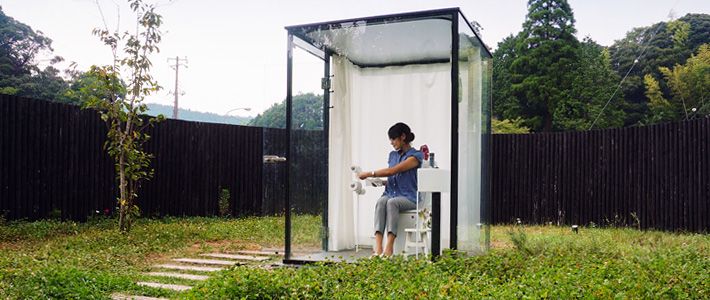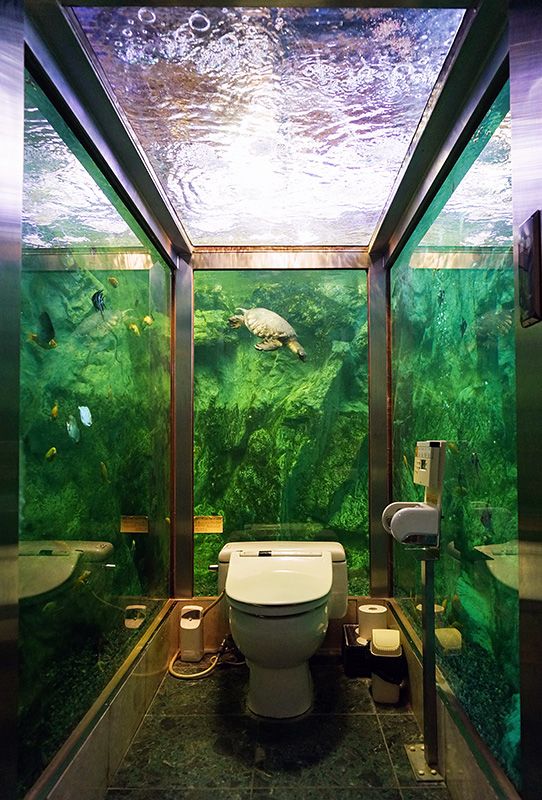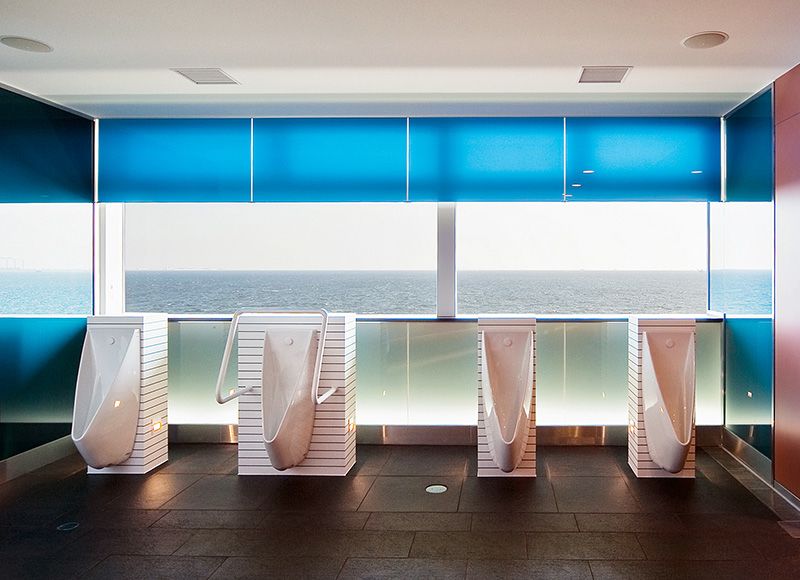
Japan’s Top 12 Restrooms
Guideto Japan
Culture- English
- 日本語
- 简体字
- 繁體字
- Français
- Español
- العربية
- Русский
Extraordinary Restrooms
Visitors to Japan are often fascinated—and often bewildered—by the many functions of the nation’s high-tech toilets. They can form the basis for memorable experiences, inspiring some people to go so far as to take one home as a souvenir. While old-fashioned squat toilets remain the standard in some locations, public facilities tend to be clean, well-maintained, and free of charge. Beyond the standard conveniences, however, there are numerous extraordinary restrooms out there.
 Maritomo, wearing her trademark toilet hat.
Maritomo, wearing her trademark toilet hat.
For more than a decade, the self-described “toilet hunter” Maritomo has sought out Japan’s most unusual restrooms. She has visited more than 300 and documented 249 of them in the book Nippon no toire hoka (Japanese Toilets and More). She makes frequent television appearances and contributes writing to print and online publications about her area of expertise.
Why the fascination with the loo? “Everyone has to use the toilet several times a day,” she explains. “The restroom is also important as a private space where you can be alone.”
Maritomo believes that Japan pays particular attention to restrooms. “A restaurant’s toilets reflect the motivation of the owners and staff. Japanese people think that even if they enjoy their time at a restaurant, it spoils the atmosphere if the restrooms are dirty when they visit.”
Below we list Maritomo’s top 12 toilets. You may find them so compelling that you just have to go.
1. Golden Toilets
 Photo from Japanese Toilets and More.
Photo from Japanese Toilets and More.
The Robot Restaurant in Tokyo’s Kabukichō district demonstrates how a good concept can bring huge success. Its combination of dancing women and robots has made it a standard stop-off for many foreign visitors to the capital. The owners have not skimped on decking out the restrooms either.
MARITOMO The golden toilets have been remodeled and upgraded many times. The photographs in my book show how they looked when the restaurant opened, so they are now a valuable document. Total construction fees for the building were more than ¥10 billion, and the designers seem to have spent a lot on the toilets. I take my hat off to the uncompromising design.
2. Garden Toilets
 Photo from Japanese Toilets and More.
Photo from Japanese Toilets and More.
Resuto Ujō is a Japanese restaurant that provides the atmosphere of a traditional garden in the restrooms. It is located on the Echizen Coast in Fukui Prefecture.
MARITOMO These restrooms are popular as customers can enjoy relieving themselves in a Japanese garden. They come for the wonderful toilets as well as the fine seafood cuisine. There are seven toilets in all, with names matching their various themes.
3. Aquarium Toilet
 Photo from Japanese Toilets and More.
Photo from Japanese Toilets and More.
The restroom at the Hipopopapa restaurant in Akashi, Hyōgo Prefecture, is literally in an aquarium. After gazing at the sea during their meal, diners can feel like they’re voyaging beneath the waves when using the toilet.
MARITOMO Many users are so overcome by the situation, they forget to lock the door, so the restroom has two lockable doors. It was a challenge to construct, with the weight of the water cracking the glass before a sturdier design was created, and it apparently cost more than ¥20 million to build and maintain.
4. Ski Jump Toilet
 Photo from Japanese Toilets and More.
Photo from Japanese Toilets and More.
Users feel the thrill of crouching at the entrance to a ski jump ramp at this toilet in the Haiji restaurant at Nagano Prefecture’s Madarao Kōgen ski resort.
MARITOMO A sticker with a printout showing the view from the Nagano Olympics ski jump platform covers the walls. There is also a photo of skis on the floor, so users get a real sensation of looking down the slope, reaching a maximum 37.5º incline, to the runout 136 meters below. As the restaurant is in a ski resort, people sitting in their winter ski wear are certain to feel even more like a real jumper.
5. Sea View Toilets
 Photo from Japanese Toilets and More.
Photo from Japanese Toilets and More.
The bridge and tunnel of the Tokyo Bay Aqua-Line cut directly across the bay, and the toilets in its Umihotaru service area make the most of the location.
MARITOMO The toilets are at Japan’s only service area on the sea, allowing users to experience the freedom of the ocean vista as they answer nature’s call. The ocean-facing space in the women’s toilets features washbasins instead of urinals.
6. Nature Toilet
 Photo from Japanese Toilets and More.
Photo from Japanese Toilets and More.
At 200 square meters, this is a little large to be called a “cubicle.” Garden Toilet, which can be found at Itabu Station in Ichihara, Chiba Prefecture, is claimed to be the world’s biggest.
MARITOMO Its official name is Toilet in Nature. This facility was designed so users could enjoy the bountiful nature of Ichihara while relieving themselves. It’s a women’s toilet, so unfortunately men can’t experience it. You can pull the curtain around you, but there is still such a sense of open space—just like being outdoors—that you hesitate to perform your business.
7. Paper Toilet
 Photo from Japanese Toilets and More.
Photo from Japanese Toilets and More.
There’s no need to worry about running out of toilet paper at Momojirō, a restaurant in Sakyō, Kyoto, where holders cover a whole wall.
MARITOMO There are 81 holders in total in the women’s toilet, with the ends of each roll folded into neat triangles. I heard that they accidentally ordered too many, but instead of sending them back, decided that the stylish thing to do would be to make use of them all. It must be tough for the staff members who have to regularly check the stall and fold the roll tips into triangles, though.
8. Japan’s Oldest Toilets
 Photo from Japanese Toilets and More.
Photo from Japanese Toilets and More.
Japan’s oldest toilets still in existence can be seen at the temple of Tōfukuji in Higashiyama, Kyoto. The room is huge, at 35 meters long and 14 meters wide, and has been designated an important cultural property. For this reason, it is only possible to look, and visitors cannot make use of the historic holes.
MARITOMO The room can be used by 100 people simultaneously. In the old days, sewage could be sold as “night soil,” or fertilizer, so it provided an important source of income for the temple. For this reason, there were many rules for use, and it’s said that for Zen priests, going to the toilet was a part of ascetic training.
9. Zen Toilets
 Photo from Japanese Toilets and More.
Photo from Japanese Toilets and More.
These toilets are at a Zen training hall in Fukuroi, Shizuoka Prefecture. The restroom is dedicated to Ususama Myōō, known as a toilet deity with powers of purification.
MARITOMO Unusually, this is a “mixed toilet” for use by all genders. As well as the Buddhist statue, there is a saisen-bako, or box to make offerings to the temple. In other countries, many toilets require a small payment. Making a donation in that spirit may bring you good fortune.
10. Toyota Toilet
 Photo from Japanese Toilets and More.
Photo from Japanese Toilets and More.
The popular ramen chain Ippūdō has been expanding overseas. The restroom at one of its Japanese branches, on Honmachi-dōri in Nagoya, Aichi Prefecture, pays tribute to Toyota, which is based in the prefecture.
MARITOMO Instead of simply lining up some automobile-related goods, it was an amazing brain wave to hack up a real engine and create a beautiful display on one wall, using the parts as objets d’art. Ippūdō cuts no corners at restrooms in its other stores too, like the one in Kurashiki, the home of Japanese jeans, which has denim wallpaper.
11. Retro Room Toilet
This restroom is based on the playful concept of a room belonging to the character “Peter,” a 27-year-old from Seattle who is a big fan of the 1980s. It is the brainchild of the owner of Sundubu Tōfu House, a restaurant in Okayama, Okayama Prefecture.
MARITOMO The owner wanted customers not just to enjoy the food, but also to come away from the restaurant with a story to tell. With so much attention to detail, users might wonder if they’ve wandered into someone’s apartment instead of the restroom. It’s a fun approach to overturning preconceived ideas of what a toilet space is meant to be.
12. Sentō Toilets
This restroom has a picture of Mount Fuji, as is commonly seen in sentō, or public bathhouses. It is located at Nidaime Yoichi, a restaurant in Ōita, Ōita Prefecture, famed for its ryūkyūdon, chopped fish and green onions on a bed of hot rice.
MARITOMO This is an exhibit in the 2015 Ōita Toilennale, a festival that targeted urban revitalization through a fusion of toilets and art. You can relax as you relieve yourself, as if you’re gazing at Mount Fuji while soaking in a hot tub.
Maritomo’s book, Nippon no toire hoka (Japanese Toilets and More), is published in Japanese by Aspect and costs ¥1,000 plus tax. It includes photographs of fun and interesting restrooms around the country that she has discovered over more than a decade of toilet hunting.
(Originally published in Japanese on January 27, 2017. Text by Nippon.com with editorial supervision and photographs by Maritomo. Banner photo: Garden Toilet.)
